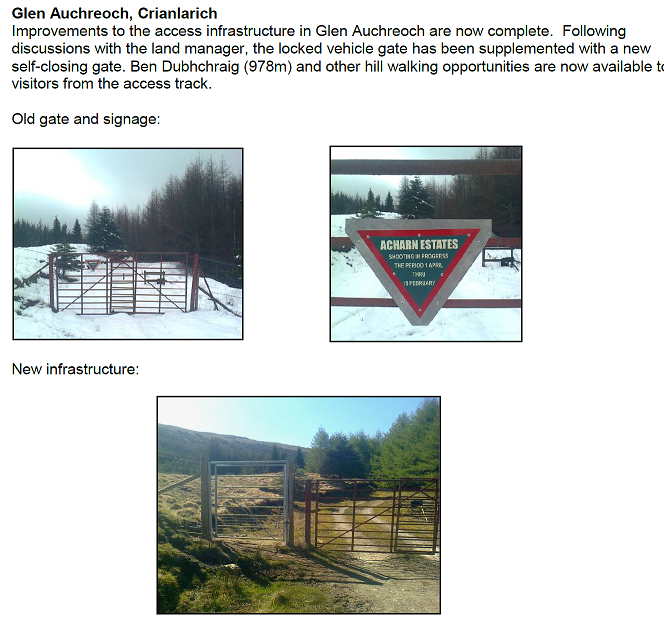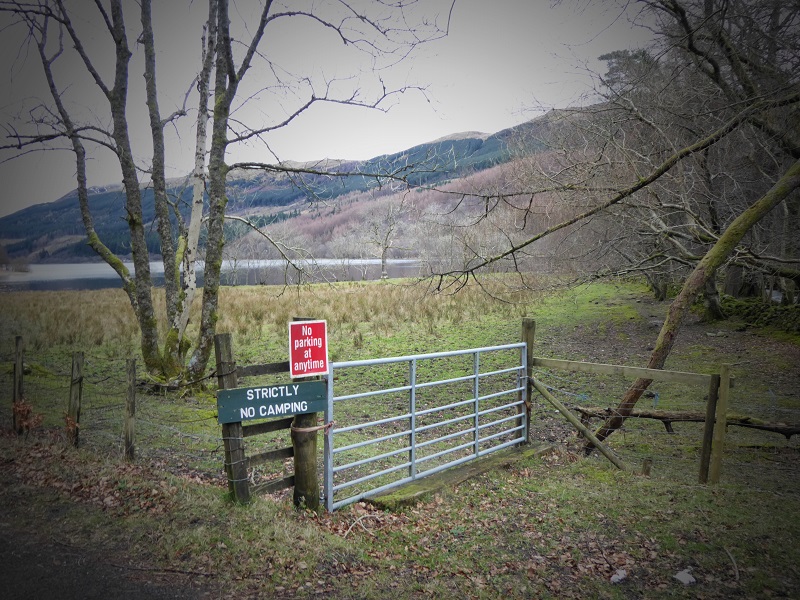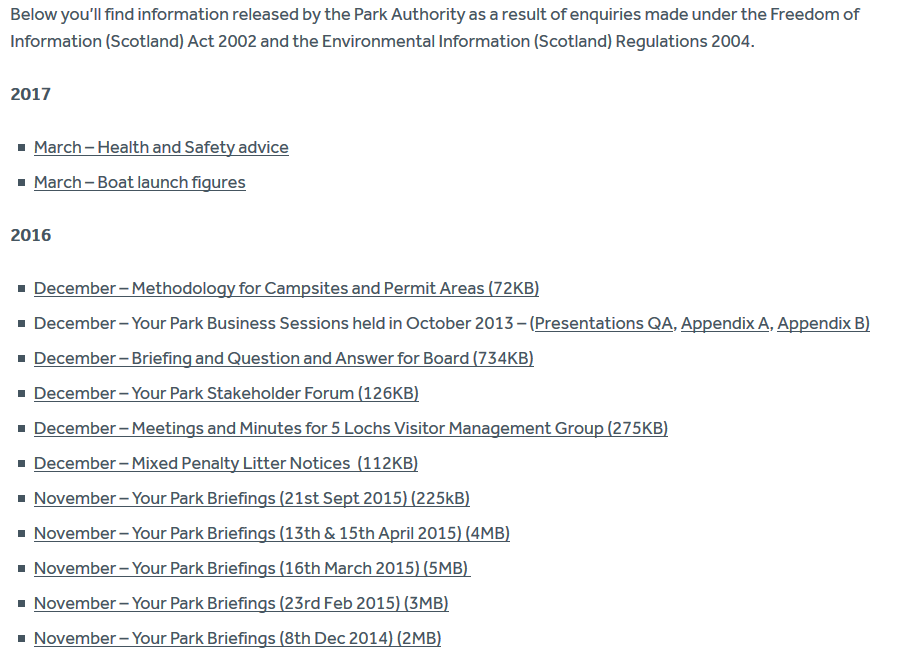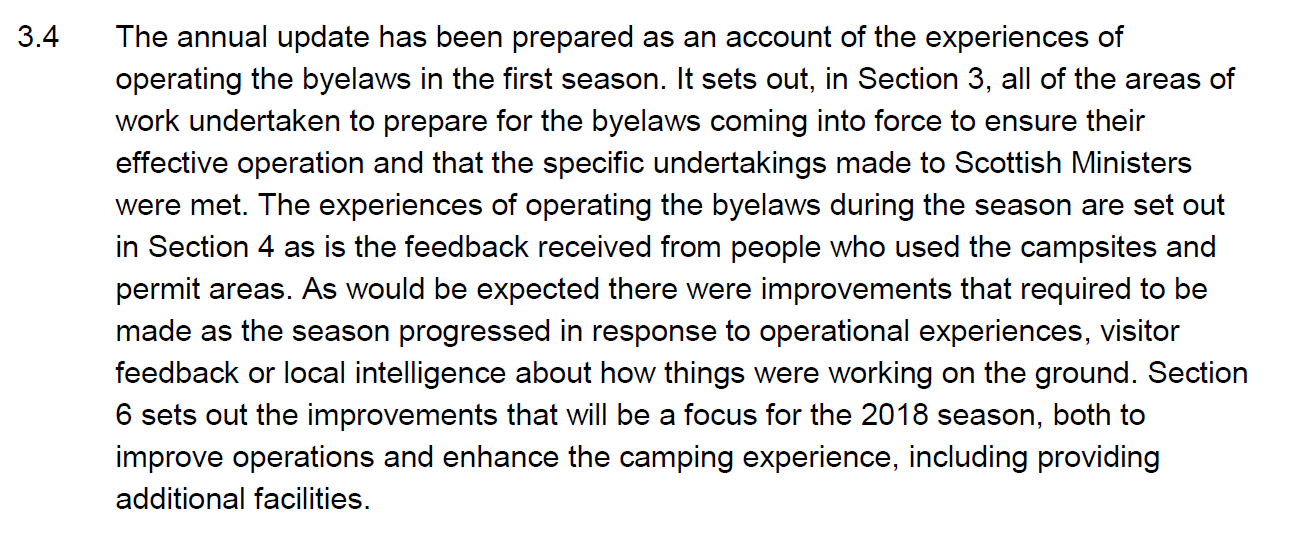 Yesterday’s post on signage in our National Parks that contravenes access rights was published before I had read the Loch Lomond and Trossachs’s National Park’s response to an information request I had made for papers presented to the Local Access Forum this year (I received the response at the end of last week). The photos above were in the report to the May Local Access Forum (see here) and show there are National Park staff who are keen to do the right thing. Well done them and I don’t want them to think that I was criticising them personally for all the anti-access signs you can find in the Lomond and Trossachs National Park..
Yesterday’s post on signage in our National Parks that contravenes access rights was published before I had read the Loch Lomond and Trossachs’s National Park’s response to an information request I had made for papers presented to the Local Access Forum this year (I received the response at the end of last week). The photos above were in the report to the May Local Access Forum (see here) and show there are National Park staff who are keen to do the right thing. Well done them and I don’t want them to think that I was criticising them personally for all the anti-access signs you can find in the Lomond and Trossachs National Park..
The shame is that the LLTNPA does not get its large marketing team to publicise such good work – it might discourage other landowners from putting up signs saying “KEEP OUT HIGH VELOCITY RIFLES IN USE” – while it has sidelined its Local Access Forum. This post considers the issues which arise from this in a bit more detail.
Addressing access issues
One thing that struck me from the access cases covered in the LAF papers, including the Drumlean Case which went to court (and the paper on this May 17 Appeal Court ruling is excellent), is that all the actions by LLTNPA staff appear to be linked to complaints. The implication is that unless the public complain, access and other problems are just tolerated. This is not just an issue for National Parks, as David Lintern’s recent excellent post on Walk Highland points out (see here). This attitude of “no complaint, no action” may explain, however, why no action has been taken against all the camping signs which have been up for years and are still unlawful under the camping byelaws.

Either Park staff, including Rangers, don’t see these and others signs and blockages as access issues or, perhaps more likely, they are not allowed to address them without a complaint being received. And the explanation for that is likely to be that if staff addressed issues without complaints, the National Park could be seen as being anti-landowner, whereas common sense says that this should be just about access staff doing their job. Whatever the case, there needs to be a complete change in culture in the National Park so staff are able to proactively take up and address access issues.
When they are allowed to do so the first major problem staff face, as illustrated by the report in the LAF papers about the Auchroach case, is finding out who is responsible:

This is not an isolated example. In the case of the bright blue car abandoned south of Inverarnan for months(see here), the LLTNPA claimed they could not take action because they did not know the landowner). The camping byelaw papers also make it clear the Park sometimes does not even know who owns what bit of loch shore. The LLTNPA, after almost 15 years of existence, still does not know who owns significant chunks of land within the National Park. A matter of public interest and a fundamental issue for land reform as well as one that wastes huge amounts of staff time. One might have thought their Board would have made representations about this but instead silence or worse (the LLTNPA mad a submission to the Land Reform Review Group, which reviewed the Land Reform Act 2003, but instead of raising such issues they made a submission about banning roadside camping across Scotland).
Resolving access issues at present can take years. I would like to have seen the LLTNPA in its new National Park Partnership Plan set out properly what resources (and changes to the law) are needed to secure and promote access rights in the National Park. The draft plan going to the Board next Monday does not even mention access problems. Instead, its contains pious statements saying how the National Park wish to encourage people (excluded groups to to visit) with absolutely awareness that everywhere you go now there are “No” signs.
Secrecy, the Local Access Forum (LAF) and the camping byelaws
The LLTNPA as an access authority has a duty to support the operation of a Local Access Forum and a statutory duty to consult it on access matters. The LLTNPA closed down its LAF during the time when its Board was meeting in secret to develop camping byelaws (there was one meeting of the LAF a week before the formal consultation was issued by which time all had been decided). Since the byelaws were agreed by Ministers the LAF has been resuscitated.
The LAF is now listed under the Board Committee section of the LLTNPA website (see here) and was scheduled to meet four times this year (although the website says it usually meets just twice). Unlike other Board Committees, however, papers for meetings are not published as a matter of course. By early Autumn this year no minutes for the 3 meetings that had taken place had appeared either, making it impossible to see what the LAF had been doing. This was not the LAF members responsibility or fault, but the Park’s.
After I raised the matter with Park Senior Management I got this response:
We can confirm that the Local Access Forum met in January, May and August. With regards to the papers being on the website, all minutes are normally published once approved by the Forum. Unfortunately, due to an oversight, this did not happen earlier in the year, this has now been rectified and you will note that links to all minutes from previous years are available. The minutes for August will be published after they have been approved at the December meeting. Your query regarding papers has been passed to the Access team for consideration.
Now I don’t believe it either is, or should be, up to the Access Team to decide if papers to the LAF are published or not (although I suspect if the decision was up to them they would publish as it would help advertise the work they are doing). The LLTNPA in its Publication Scheme, which was agreed with the Information Commissioner, said it would publish information on how it makes decisions: since the LAF meetings inform what decisions are taken on access, in my view papers to those meetings should be published. The only way to get them though at present is by making an Information request, which I did.
Unfortunately, while I have obtained the papers, they are still not available on the LAF section of the website. Nor is there any link under under the Freedom of Information section of the Park website where the LLTNPA publish some responses it has made to information requests:

The LLTNPA has not published A SINGLE RESPONSE TO AN INFORMATION REQUEST since March. By contrast, the Scottish Government has now committed to publishing ALL responses to information requests made to it as a result of cross-party political pressure. There is NO reason why all our Public Authorities should not be doing the same. For the record EIR 2017-075 Response LAF shows there have been at least 75 information requests under the Environmental Information Regulations alone this year, while the screenshot above shows the Park has just published two of these. The question is why?
My suspicion, based on the content of my information requests, is this is because a large proportion are about access, including the operation of the camping byelaws. If the Park published the information, it would undermine its own case that the byelaws have been going well.
The LAF minutes (now on website) and papers Jan 17 Access team update Jan 17 Generic LLTAF YP update May 17 Appeal Court ruling May 17 Access Team Update May 17 Core Paths Plan Review Aug 17 Core Paths Plan ReviewAug 17 CPP Review PaperAug 17 LLTAF CPP slides show that LAF members are trying to raise and address access issues, from car parking charges to access obstructions, even if the operation of the camping byelaws has hardly been covered.
As evidence of the ability of current LAF members to think critically this raised a smile:

The challenge LAF members face though is that if little of what they contribute is made public they are hamstrung, and its very easy for the LLTNPA to sideline them. A recent example comes from the Information Response I received from the LLTNPA which indicated the December meeting of the LAF has been postponed (which in turn means the minutes of the August meeting are not yet public). As a consequence the LAF have been given no opportunity to contribute to the review of the first year of the camping byelaws or to offer comments on the implications for access rights of the report to Ministers which is to be discussed by the Board next week.
That Board paper also fails to refer to the LAF:

It appears that once again the LLTNPA has excluded the LAF, a statutory consultee on access rights, from all consideration of the camping byelaws. I believe that says it all (though I will post on the Report for Ministers later this week). Until the LLTNPA connects with its own LAF, every recommendation or action it takes on the camping byelaws is worthless. Meanwhile, the fact that it is the only Access Authority to have a place on the National Access Forum appears to me to be a national disgrace. (It hasn’t consulted the NAF properly about the implications of the byelaws either)
What needs to happen
Access rights need to be put at the centre of what both our National Parks do.
The LLTNPA appears to have some good staff who can take on and resolve access issues, as demonstrated by the Auchreoch case, but they need to be empowered to do so far more widely. This will require both resources and a change in culture so that Park staff are able to start acting pro-actively.
The LAF needs to be put at the centre of what the LLTNPA does and should be doing to uphold access rights, instead of being sidelined as appears to be the case at present. For that to work, the LAF has to be allowed to operate openly, be given resources to publicise what it does and be supported to ensure independent effective links are in place with partner organisations, particularly recreational bodies.
Postscript on resources and neoliberalism
I suspect the LLTNPA’s response to my concerns about secrecy covered in this post would be to say my suggestions are all very well but it has not had the resources to make information public. As evidence for this it might cite its current advert for a one year Information Intern.
The advert shows that person will require a degree and be paid £16320 for a 37 hour week or £9.28 an hour.
Instead of making a coherent case to the Scottish Government about the resources it needs, the main function of the LLTNPA appears to be to manage austerity and join with other organisations in driving wages as low as possible with the excuse that nothing else can be afforded. If the LLTNPA knew who the landowners in the National Park were and had analysed their wealth they would know this is not true.

2 Comments on “The LLTNPA, the Local Access Forum and upholding access rights”